* Since publication of this post, my research into the form, flour, and tools of the trade in relation to the Panis Quadratus bread remains of Pompeii has been updated significantly and is available to read in The Bloomsbury Handbook of Experimental Approaches to Roman Archaeology. *
Questo articolo è pubblicato anche in italiano qui.
As featured in the June 2021 issue of National Geographic
As a part of my ongoing research into Roman breads and the Panis Quadratus, I have been delving deeper into the archaeological and documentary records, looking for evidence of the many weird and wonderful ingredients that are incorporated into Roman breads, as this is an integral aspect of exploring the sensory aspects and preferences of Roman bread-making. Taste and texture are determined by the ingredients and food technologies that were used in the Roman Mediterranean. We often see the words ‘spelt’ and ‘wheat’ being used when referencing Roman bread ingredients but this is only a fraction of the big picture. There was so much more involved in Roman bread-making than just the flour that held the loaf together, so many variables, which is why I have decided to write a series of posts about the many varieties of Roman breads and the key ingredients found within them… For this installment, we will explore an unusual bread offering… while asking ourselves: “Why don’t we make bread like this anymore?!”
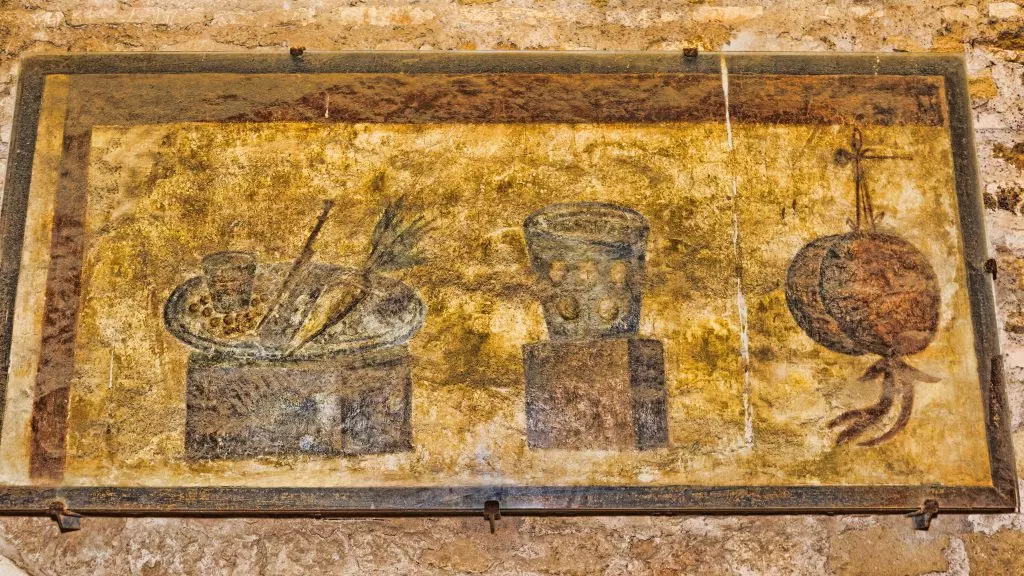
While doing some recent research into Classical Mediterranean food frescoes in the 1st century AD, I stumbled upon an intriguing passage written by Philostratus, a Greek-born Imperial Roman-era sophist who settled in Rome. The passage describes a food still-life painting, and a Greek hospitality concept called: xenia. In these paintings we may encounter scenes of food being presented to guests themselves or just still-life depictions of food meant to be viewed by an observer that is external to the painting. The painting Philostratus refers to depicts food provisions that are offered to an esteemed guest to inform them of what has been procured for them during their visit. What a privilege that must have been! But why make a big fuss and commission an artist to paint a bunch of figs and rabbits on a board, you ask? Why not just slip a wax tablet under the chamber door with today’s menu like the Room Service order-card at the Marriott? Well, what’s telling about this convention, which is possibly what we are witnessing in other Roman-era food frescoes as well, is that it’s likely a bit of ‘food-flaunting’ but it is also a visual representation of food-stuffs portrayed and observed by people who may be illiterate. The majority of people in the Classical Mediterranean were illiterate with the exception of some scribes, poets, playwrights or educated members of the elite classes who made up a small percentage of the population who communicated and recorded history, science, nature, laws, theatrical works and poetry in the documentary record. These records, of course, also include more specific and brief administrative written communications such as epigraphy and graffiti which can be found painted on amphorae or the walls of Pompeii or commemorative writings carved into stele and other forms of monumental architecture.
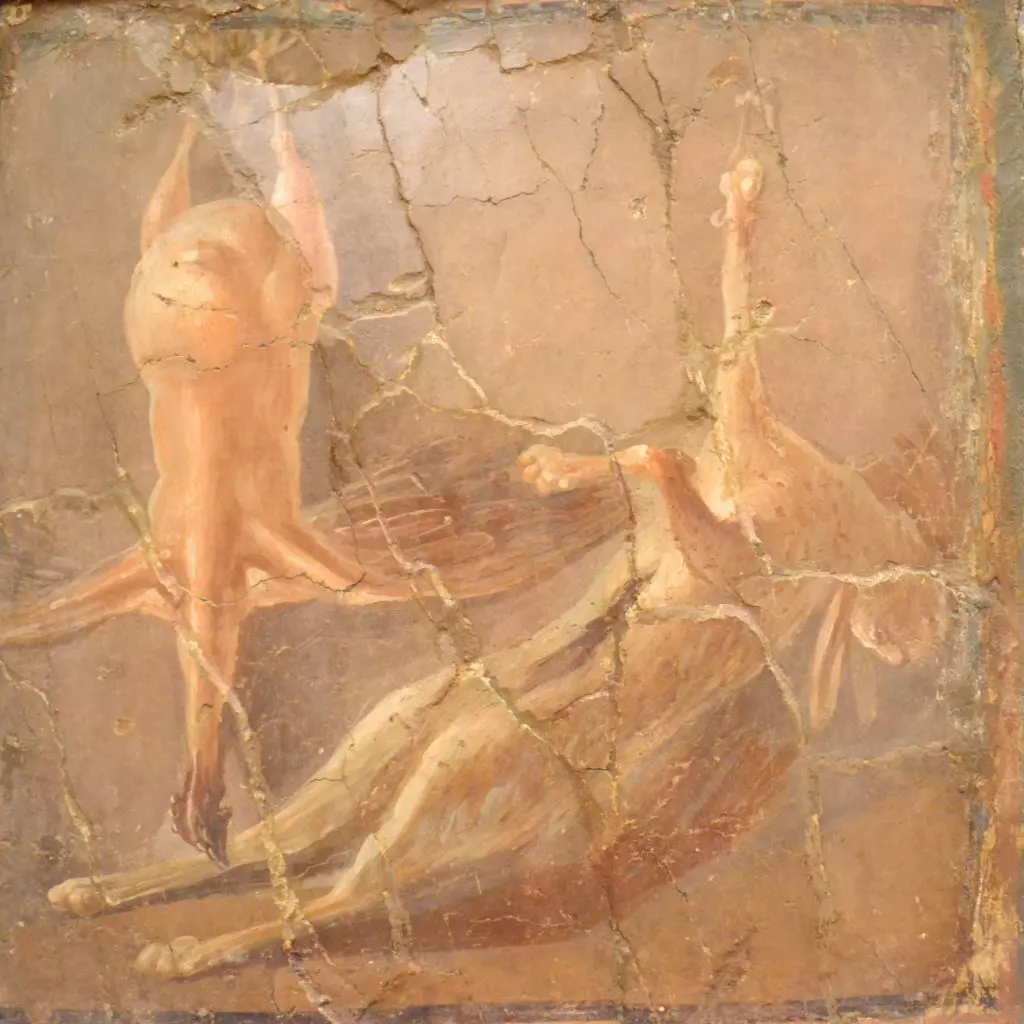
In Philostratus’ xenia scene, the description of the painting depicts a survey of the spoils from a successful day’s hunting and gathering. The passage begins with a description of what we, the viewer, are seeing in the xenia scene:
“This hare in his cage is the prey of the net, and he sits on his haunches moving his forelegs a little and slowly lifting his ears, but he also keeps looking with all his eyes and tries to see behind him as well, so suspicious is he and always cowering with fear; the second hare that hangs on the withered oak tree, his belly laid wide open and his skin stripped off over the hind feet, bears witness to the swiftness of the dog which sits beneath the tree, resting and showing that he alone has caught the prey. As for the ducks near the hare (count them, ten), and the geese of the same number as the ducks, it is not necessary to test them by pinching them, for their breasts, where the fat gathers in abundance on water-birds, have been plucked all over.
– Philostratus the Elder, Imagines, Xenia II.26 (1st c. AD)
The passage then shifts as the painting seems to directly address the viewer as it offers the viewer a choice of other foodstuffs located in the painting:
“If you care for raised bread or “eight-piece loaves,” they are here near by in the deep basket. And if you want any relish, you have the loaves themselves—for they have been seasoned with fennel and parsley and also with poppy-seed, the spice that brings sleep—but if you desire a second course, put that off till you have cooks, and partake of the food that needs no fire. Why, then, do you not take the ripe fruit…“.
– Philostratus the Elder, Imagines, Xenia II.26 (1st c. AD)
Do you just see what I see?… Philostratus describes bread that incorporates poppy seeds, fennel and parsley! How unusual and exciting… and it comes in ‘eight pieces’…. EIGHT PIECES! Ceres have mercy! Is old Phil telling us that some Panis Quadratus loaves (known as Kodratoi to the Greeks) may have also incorporated poppy seeds, fennel and parsley into the bread’s recipe? It certainly sounds this way, doesn’t it? But before we go any further, let’s take a moment to see how other ancient writers referred to the panis quadratus:
In the 8th century BC, Hesiod (Works and Days, 442) records the panis quadratus as ‘oktáblomon’, describing it as ‘a four-piece, eight-part loaf’. In the 2nd century CE, Roman grammarian, Sextus Pompeius Festus (De verborum significatione, XVII:9), describes the loaves as being shaped like a wheel and used in a ritual capacity during the festival of Summanalia. The loaves are then referred to as ‘oktablómous’ by Philostratus of Lemnos (Imagines 2.26. Xenia) in the 3rd century AD. It is Athenaeus of Naucratis (Deipnosophistae, III:114e), in the 3rd century AD, who then states that the Romans called bread ‘panis’ (Deipnosophistae, III:111c) and that the loaves known to Greeks as ‘blomiaioi’ (Deipnosophistae, III:114e), which were broken into parts, were called ‘kodratoi’ by the Romans. The name of the loaf is thus Latinized as ‘panis quadratus’. The 1st century Roman poem ‘Moretum’ (Appendix Vergiliana; L48) provides readers with an actual image of how a panis quadratus was made in a domestic setting by a ploughman who marks his bread dough into equal segments prior to baking. Between Hesiod and Athenaeus, that’s over a thousand years of panis quadratus represented in Greek and Roman literature!

After reading the section from Philostratus’ ‘Xenia‘ and doing more research on Roman food frescoes housed at the Museo Archeologico Nazionale di Napoli… I decided that I was going to prioritize this bread recipe, experiment with recreating it, and get it up on the site without delay … and then National Geographic called.

After a series of conversations with a wonderful group of people at Nat Geo (more on this very soon!) they asked if I wouldn’t mind sending some bread to their offices in Washington, D.C.. Naturally, I happily obliged and decided that I would recreate a few loaves of the xenia kodratoi for them, made the old-school way, from start to finish. All hands were on deck for this project: Popidius, my bread starter that was inoculated in the bakeries at Pompeii; my trusty manual hand-mill that processes cereal grains beautifully; the outdoor summer heat and humidity that brings bread-dough to an incredible rise, and my wood-fired, outdoor, beehive oven that bakes hand-made bread better than a conventional oven, any day. This was an all-day baking project that was nothing short (well, it was a donkey short, to be honest) of a one-woman Roman bakery operation in my own back yard. Popidius Priscus would have been proud of me, to be sure. He may have also laughed his flour-covered belly off to see me wrenching my hand-mill winch round and round, in lieu of a donkey… hour after hour… singing Depeche Mode songs to keep me moving while I milled two kilograms of flour. But all of it, every second of it, was worth it. With the xenia image in my mind and the excitement of the new ingredients being incorporated into the infamous Panis Quadratus/Kodratoi loaf, I was in my bread-nerd happy place. And I know that I’m not the only bread-nerd around here (yes, I am looking at you, good reader) so I’m going to leave this recipe right here for you to try as well! But first, a word about flour varieties in ancient Rome. Many types of cereal grains were in use to make bread in ancient Rome and these grains had varying weights, different textures, and varying price points. And the flours that each grain produced, at varying weights and extraction rates, had different ratios of water absorbency. While durum wheat may have been the most frequently used wheat to produce bread in 1st century Roman settings, it cannot be ruled out that common bread wheat was also in use, particularly in regions of the Empire that could grow it or afford to buy it. The problem at hand in distinguishing common wheat from durum wheat in the archaeological record is that the two cannot be told apart when being analysed by archaeologists or archaeobotanists. Therefore, with your tastebuds and dental integrity in mind, I have opted to use common bread wheat for the recipe below. Heck, wealthy resort-dwelling Pompeians probably could afford common bread wheat and their hinterland was the fertile Campanian plain!
To make Philostratus’ Panis with Poppy Seed, Fennel and Parsley, here’s what you’re going to need:
Philostratus’ Panis Quadratus with Poppy Seed, Fennel and Parsley
Note: this recipe is inspired by the research of the author and is developed for a non-academic, lay readership. It does not reflect the ingredient quantities or ratios proposed by the author in her academic publications.
Ingredients for One Loaf:
- 6.5 cups / 850 g of coarse, whole wheat flour
- 1/4 cup / 40 g of bread starter
- 2+1/8 cups / 500 g of tepid water*
- 1.5 tsp / 7 g of salt
- 2 tsp / 7 g of poppy seeds
- 2 tsp / 7 g of fennel seeds
- 1/2 cup / 30 g of finely diced Italian parsley
- Additional flour for dusting
*Nota bene: Your choice of flour (fine/coarse ground) may affect the hydration of your dough. Work to achieve a firm ball of dough that isn’t tacky and wet but also isn’t too dry and leaves flour behind. Adjust your water and flour content to achieve a firm ball of dough.
Implements:
- Twine
- A reed, a thin dowel, or your very own Panis Quadratus Bread Wheel-Press
- A sharp knife
Preparation:
Note: If you do not have a bread starter at home, you may want to start by growing one first. You can use Pliny the Elder’s recipe on this site… or you can open the gates of hell and release the Kraken by making my recipe for Chickling Vetch Sourdough Bread Starter that literally cuts your baking day (and your ceiling) in half. If you know Atillius, you know what I am talking about. Alternatively, you can also mix the same volume of flour and water with a tsp of baker’s yeast to create a sponge. Once the sponge has risen, add it to the recipe as a starter.
Note: If you’d like to mill your own flour, send me an email and I can refer you to a few stone rotary hand-mills on the market and a reliable Bengay supplier.
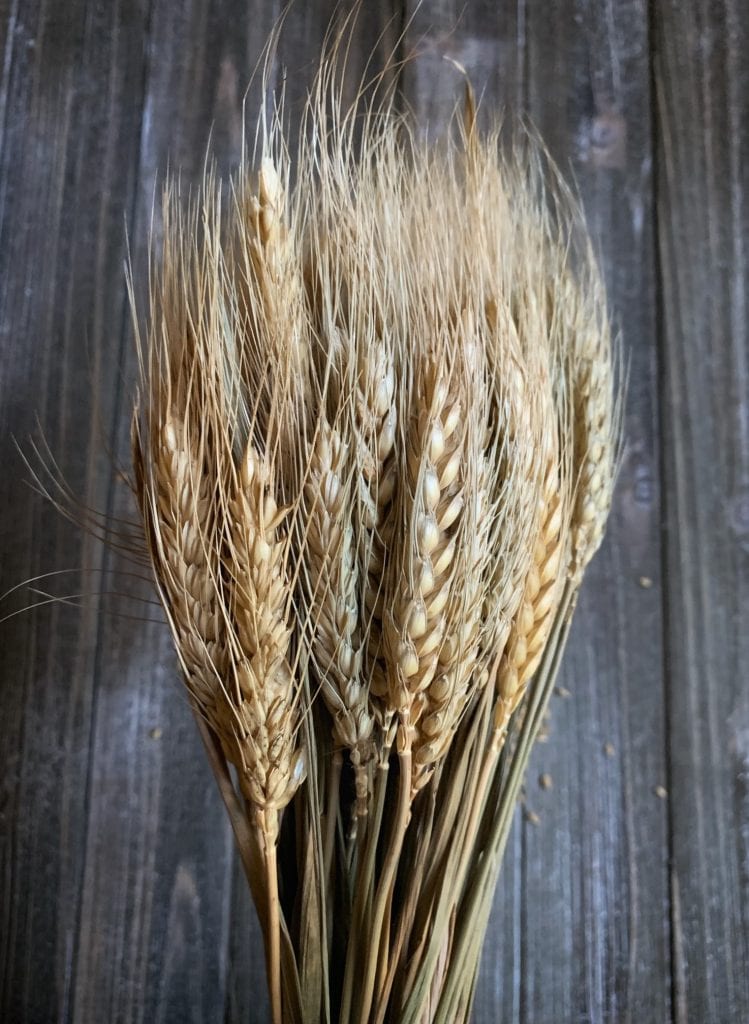
Making the Dough (for two loaves):
- Begin by dissolving your starter into the tepid water.
- Add the poppy seeds, salt, fennel and diced parsley to the flour and quickly fold it all together evenly.
- Add the water and starter into the flour and knead the flour and water together. You can do this in a large mixing bowl or on a clean surface by creating a cavity in the flour and adding the water to the centre, folding the dry into the wet until you have a mass of dough.
- Knead the dough for 10-15 minutes until the dough is a solid mass. It’s going to be quite dense. If you find that it’s too dry or you’re still trying to pick up flour, add a bit more water (not too much though) and keep kneading.
- Place the dough in a warm, humid place and cover it with a clean, damp cotton tea-towel. The damp towel will keep the dough surface moist. Let the dough rest for approximately 2 hours.
- The dough should be roughly 1.3 kg of bread dough which is the equivalent of 4 Roman libre, the amount of bread dough required to make a panis quadratus that matches several of the archaeological specimens found at Pompeii and Herculaneum.
- After 2 hours or so, stretch and fold the dough over itself a few times. Then, tucking the sides under and towards the centre, create a round formation. You can use your hands or a bench-knife to control the underside of the dough and shape it as you work it.
- Place this dough on a dusted surface or on the sheet that you will bake it on and cover it again with a damp tea towel.
- Let the dough rest and rise again for another 2-3 hours in a warm and humid place.
- Note: You may require longer rise times if your starter is sluggish or if your kitchen is cold. Give the dough enough time to rise a bit and don’t bake it too early but don’t let it over proof either.
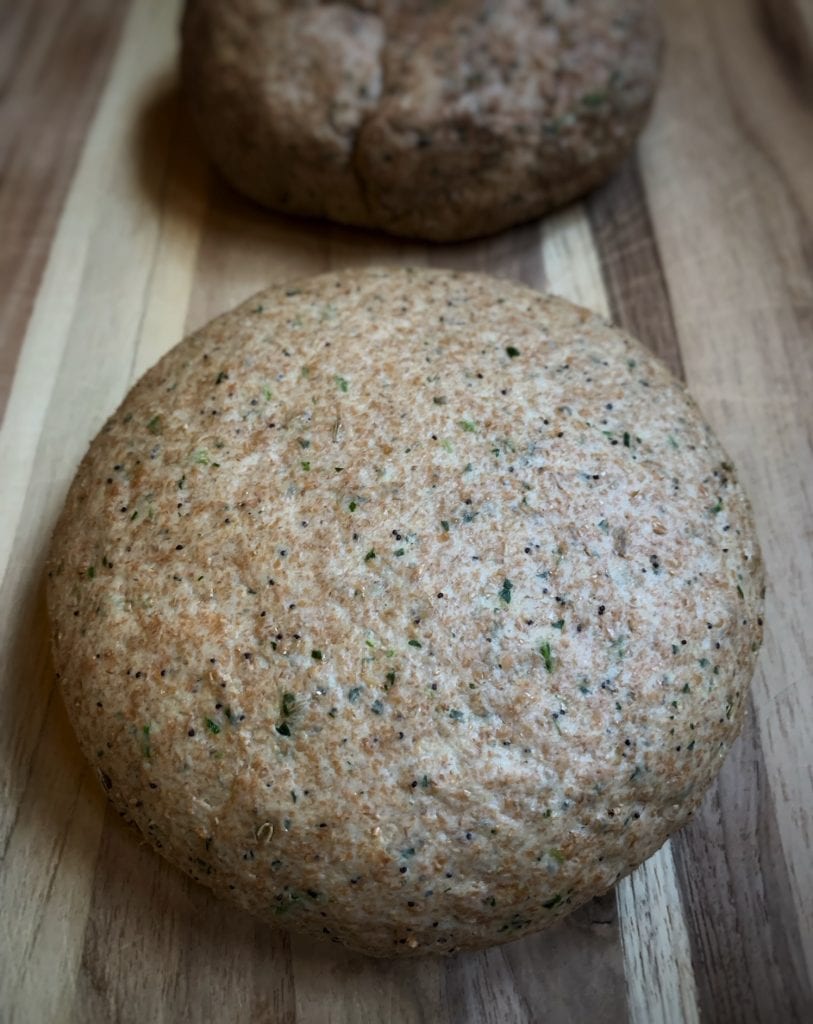
Forming the Loaf:
- Once the rounded dough has begun to inflate, preheat your oven to 375 F / 190 C / Gas Mark 5
- Dust the top of the loaf with some semolina flour to create a dry working environment on the surface of the dough.
- There are three consecutive moves involved in creating the infamous form of the panis quadratus: a) Forming the belt-line around the horizontal perimeter of the loaf; b) Forming the wedge impressions on the top of the loaf; 3. Creating a central cavity/slit on the top of the loaf to allow hot air to cook the loaf’s interior crumb during baking.
- Start by tying off the loaf around the horizontal perimeter. I called it ‘the belt-line’ and the Italians call it la cintura… so, let’s give the loaf a belt. I believe that string was tied around the circumference of the panis quadratus for several reasons: to conserve oven floor space during baking; and to allow the finished loaves to be looped onto wooden poles which were supported on the shoulders of the hawkers and porters who sold them outside of the bakeries on the streets and in macella, as seen in the image below. You want to cut approximately 82 cm of twine (or more) and try to wrap it around the loaf at the mid-section, twice, and tie a single-knotted bow to secure the twine. Cut any leftover longer pieces of twine from your bow.
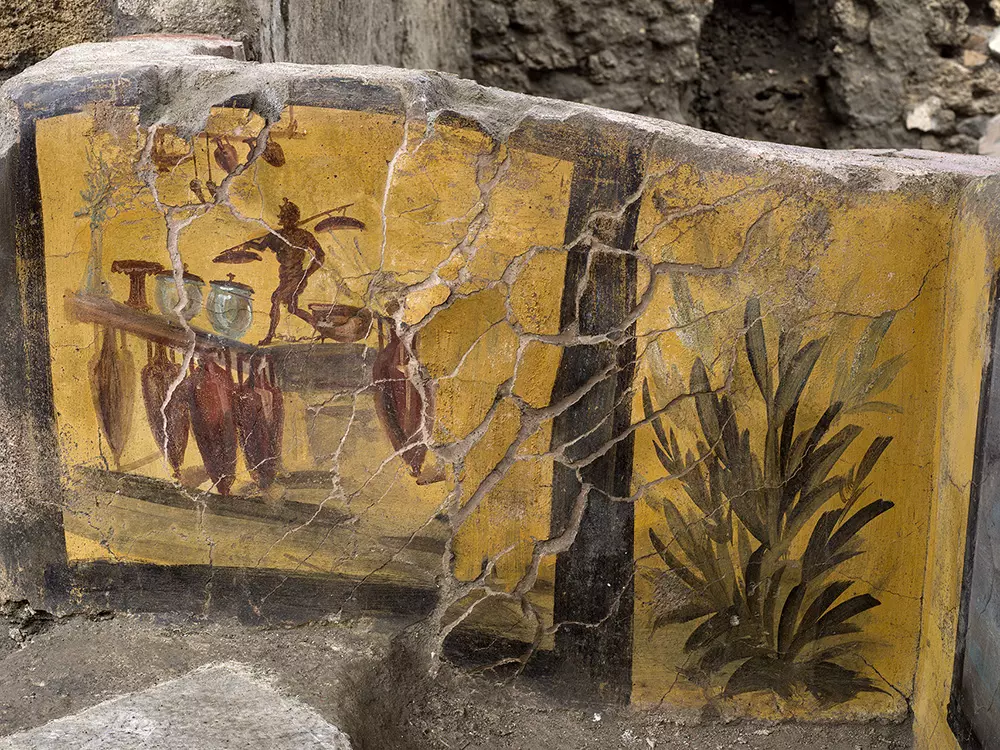
Sectioning the Wedge Portions
- Using the method of your choice, create the eight wedges on the top of the loaf. This can be done with twine, a reed, a skewer or the panis quadratus bread wheel-press which is now for sale on this site! I use twine as it is a tool already in the bakery labourer’s toolkit.
- Make sure that you have enough semolina on the top of the loaf when you create the wedge impressions. The dough is of a lower hydration so you should not have any trouble but to keep the dough from sticking to your twine or skewer, make sure the top of the loaf is lightly dusted.
- Take a sharp knife, or the tip of a reed, and press it into the centre of the loaf straight down to the bottom of the loaf. Don’t cut side to side or make a long cut. Just punch a small hole into the centre of the loaf, at the junction of the wedge lines, and create a cavity for air to get into once the loaf is baking.
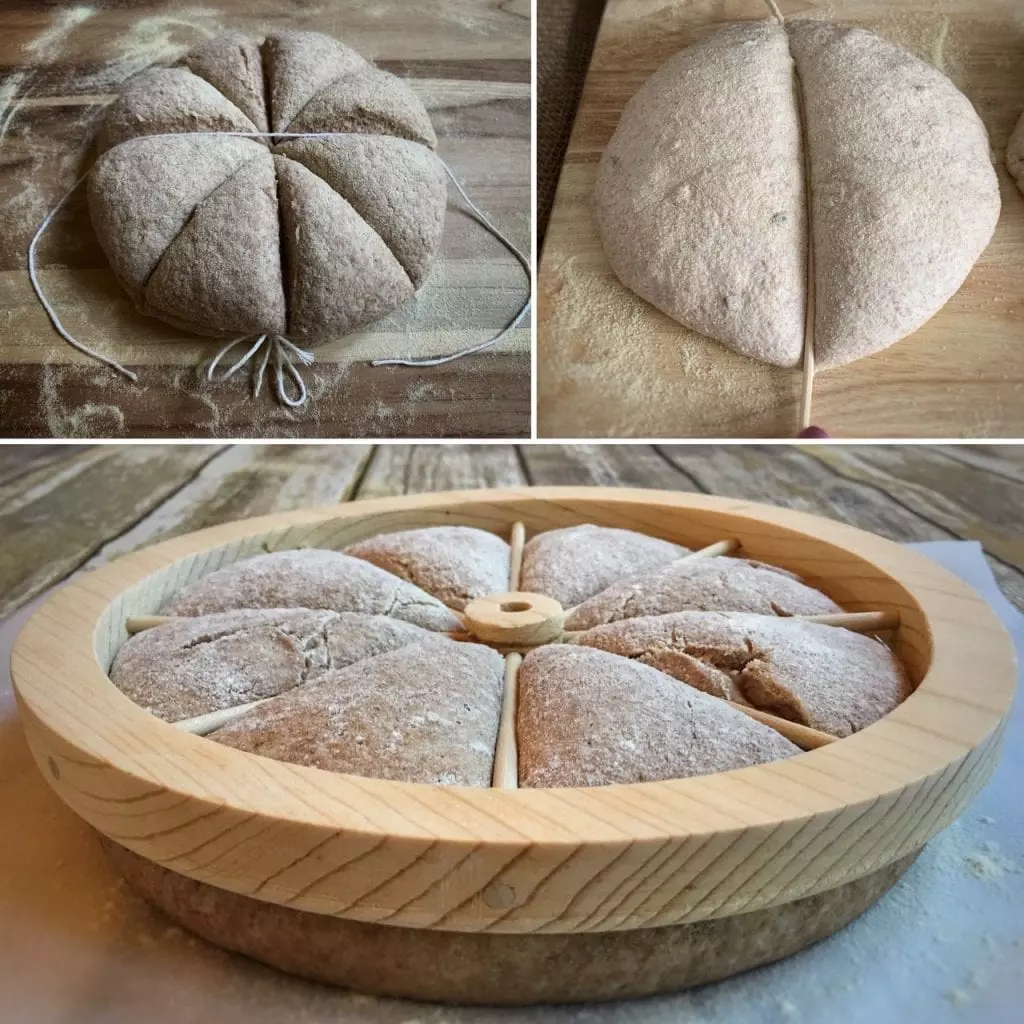
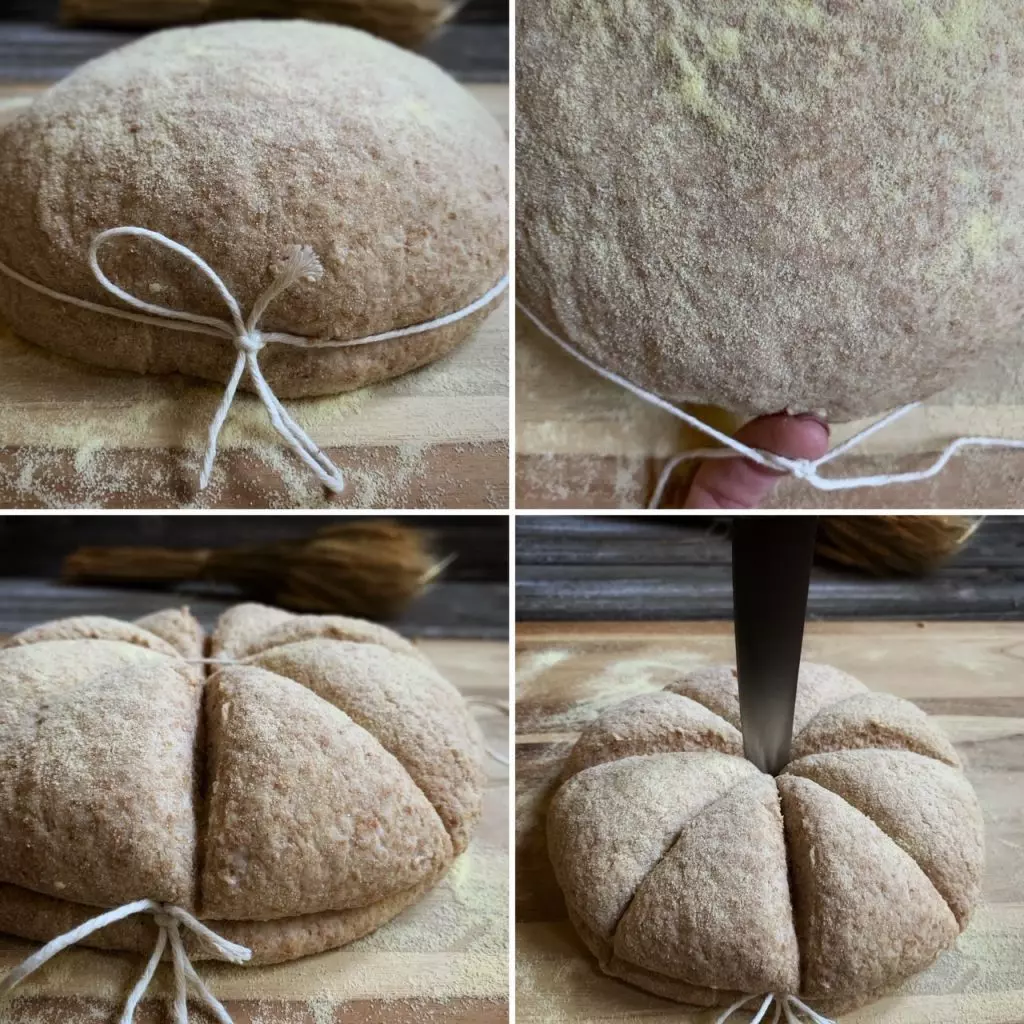
Baking the Loaves:
- Bake the loaves for 60 mins.
- Put the kettle on and give yourself a pat on the back! You’ve done a lot of hard work to get these loaves into the oven!
- The loaves will be fully baked between 60 minutes when the exterior is a nice amber brown.
- Once the loaves have baked fully, remove them from the oven and let them cool for a few hours….
- And then tasting time begins!

Now here is when we want to return to the words of Philostratus again:
“If you care for raised bread or “eight-piece loaves,” they are here near by in the deep basket. And if you want any relish, you have the loaves themselves—for they have been seasoned with fennel and parsley and also with poppy-seed, the spice that brings sleep.”
– Philostratus the Elder, Imagines, Xenia II.26 (1st c. AD)
So let’s not put anything on this bread at all! Let’s follow what was written, break the bread open with our bare hands, and taste the crust and crumb alone without any oil, wine, or water. I think you’re going to be surprised by how complete this loaf is on its own, without any ‘relish’, as our friend Philostratus says.
This experiment produced a loaf that is aromatic, flavourful, hearty and filling. The crumb is fragrant with scents like that of a garden in the summertime. There’s something very summery, fresh, and ‘herbal’ about this loaf. It’s hard to explain but the combination of parsley and fennel together, which is something most of us are not used to, adds a flavour to the crumb that is so clean, fresh and summery. That said, this is also a dense loaf and there’s the slightest hint of smoke in the crust from the fire inside the oven. It’s intoxicating! There is still a nuttiness of the whole wheat present in the flavour of the crumb, behind all of the fennel and parsley, and a hint of tang from the starter that controls some of the brighter fragrant flavours that pop out when you bite a fennel seed or get a pop of a poppy seed on your tongue. It’s very pleasurable eating this loaf without anything at all but, if old Phil turned his head, I might be tempted to drop a wedge into a bowl of hot salty broth, a cup of robust red wine, or sop up a plate of peppery olive oil with it.
Making this new panis quadratus recipe was truly a labour of love and discovery because what resulted from these efforts was not only worthy of a National Geographic bread-tasting but it was an exercise in experimental and sensory archaeology that resulted in the understanding of a whole new area of Roman bread ingredients and flavours. First the git; and now this!
In choosing to run this experiment and make this recipe using as close to the original preparation methods as possible, there were sensory elements to the process that could not be ignored: The smell of wood-smoke in your hair and on your hands as you baked and tested the heat inside the oven; the slight hint of smoke on the crust of the bread; the tougher, drier texture (unlike clibanus bread) which is common with a larger wood-fired oven; the coarseness of the flour product that went into the bread registered prominently in the crumb; the fine flour dust in your nostrils and in your eyes as you mill the flour; the ache in your shoulders and lower back from the milling and the kneading; and the rhythmic kneading and milling also compels you to hum or sing along with the rhythm in order to keep you on point while you’re working. All of these factors culminated in an introductory understanding of what manual labour in a Roman bakery must’ve been like had they only used human labour or had the donkey called in sick for work that day… 😉 And I only made two loaves! Had I made 40 I may have ended up at the chiropractor!
By the end of the long day’s work, as I stood outside under the stars pulling the last loaves out of the oven, I felt a huge sense of accomplishment and pride for the hard work that I did and I valued every single one of those loaves as a result of that labour and the resources that I worked with. To me, the loaf was worth a small fortune because it was made with sweat, hard work, wood, fire, flour, curiosity and care. There was no way that I would work that hard and make a loaf like this and then throw it out in a few days or let it grow stale on the counter. Not a chance in Hades, because I worked for an entire day making my daily bread. And this, good reader, is how most of our forefathers and foremothers felt when they grew, gathered, hunted, slaughtered and prepared their own food daily with the threat of drought, famine, poverty or war around every corner. And yet we throw our food away… daily. Without a care in the world. Perhaps more than just experimental archaeological data or an understanding of the Romans can come out of experiments like these. Perhaps we can learn to understand ourselves and our own actions better by experiencing actions and processes from the past as well? Perhaps the more that we labour over our food or connect with our food supply, the more we too will value it and protect it, just as our ancestors did before us.
Stay tuned for further updates and keep cooking it old-school!
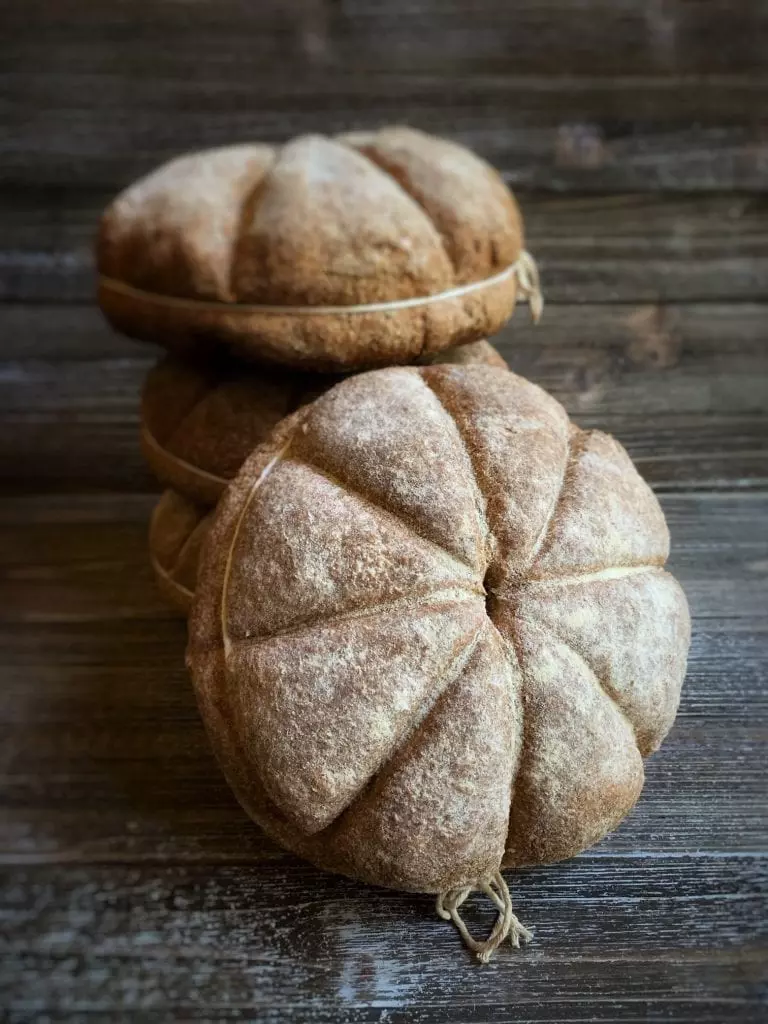
Note: If you have food-allergies and any of the ingredients found in this recipe are new to you, please consult your allergist first before trying new food-stuffs that you have not tried before! Safety first!
If you enjoyed this post, join the conversation on our Facebook, Twitter and Instagram pages! Thank you for reading and keep cooking it old school!
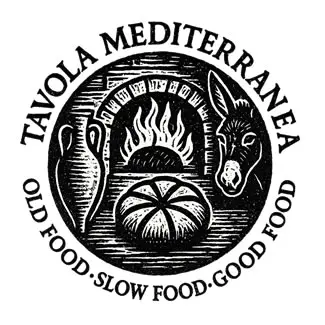
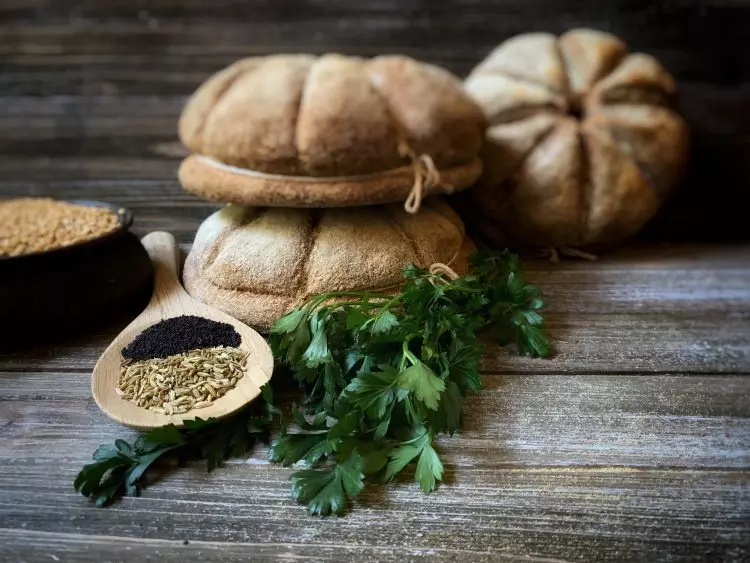
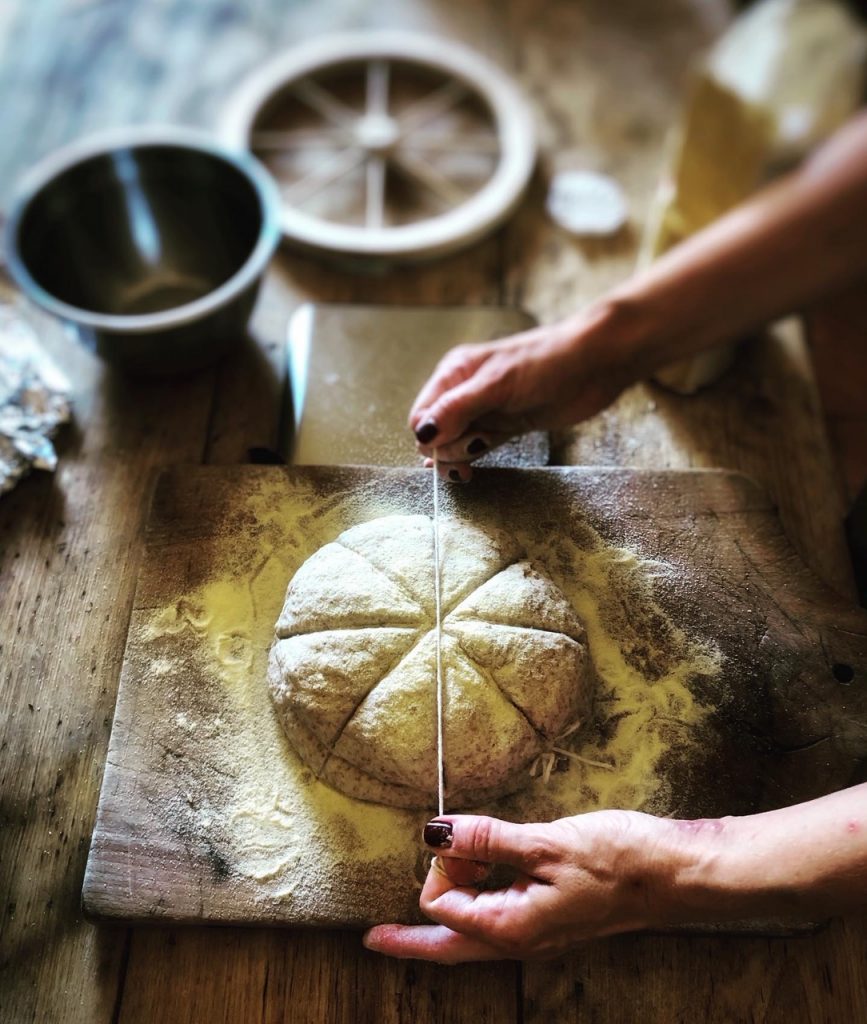





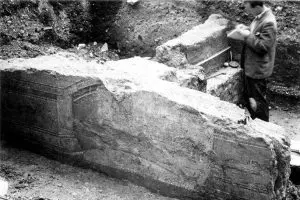


My hero, you’re not only saving my english paper about how bread changed human society but you are inspiring me to try to make this bread this week!
Hello! Going to try this recipe as soon as possible – for the yeast-based “alternative” starter, by “the same volume of flour and water” do you mean the same ratios you used for the grape leaven? Thanks so much!
No, equal parts flour and water. 1:1 ratio.
hey, thanks a lot for your article. I am in the last preparation steps and I am wondering if you use fresh or dry parsley and if you grind your fennel.
Thanks and cheers, F.
Either option is fine! Mortars and pestles were in use so grinding was a possibility, and foods were dried and preserved over the winter in ancient Rome as well so these loaves may have been prepared differently over the seasons! Post results on our FB, Insta or Twitter! – Farrell
I found your recipe through National Geographic – I loved the one-page feature in the June 2021 issue! I’ve made the recipe using a technique I’ve used for many years. After mixing the dough, I allow it to rise overnight, then shape and allow to rise in a 10.5-inch frying pan lined with parchment paper. I bake the bread in a pre-heated cast iron dutch oven with a tight fitting lid. Great results! Great flavor! Thank you for your research – so fascinating.
I too ran across the recipe in the Nat Geo article. Thanks for sharing your technique ’cause that gave me confidence of going with mine (that also uses Dutch ovens), plus adding the poppy seeds, fennel, & parsley. I use a poolish pre-ferment (not a bread starter) and would like to respect the baker’s weights in the original recipe… any advice is appreciated. Did you use exclusively whole wheat? Also, did you use the twine? Thanx!
Yes and yes. But to make modern domestic versions, feel free to experiment to your tastes and preferences!
You had me at Depeche Mode. Ill make a… less monumental effort to give this recipe a shot. I will NOT hand mill my flour. I have a grinder.
WELCOME DREW!!! 🙂
I have a question. You said each half should make 4 loaves, then said your recipe made 4 loaves. Can you clarify?
The recipe yields two loaves, each half of the dough makes one loaf. I made 4 that day but I amended the conclusion note to say two so it doesn’t create confusion. Hope that helps! Thx!
Read through all of your well researched post on Roman Bread. I tried to make my own version without any of your knowledge, and am sure to try again soon. This was just a plain wholemeal, using the string. The combination of herbs and using the sourdough element is sure to result in a perfect loaf. Many thanks for posting.
You’re welcome, Noelle! Keep baking! – Farrell
Inspired to try this after your talk at the Walters Art Museum. For the levain, I used a red millet flour from India — “ragi” — is seems to work quite well and is as easily accessible a millet flour as I can think of. I did cheat and use olive oil to protect the loaves during the first rising, but, heck, the Romans knew about olive oil. The result is quite nice though.
Bravo! Do post your pics to the Facebook page if you’re on it. We’d love to see it: https://www.facebook.com/tavolamed/
Sadly I am not on Facebook, but, the ragi really does make a surprisingly robust levain so I gave started using it as the main component in my regular levain. Glad I got hung up on how to make a Roman millet based starter.
Bravo!
found you thru saveur awards and I am in love. keep up the good work, i’ll be following along.
Thank you Hande!!! 🙂
Food back in those days and until recently was truly a labor of love, that’s why nothing was wasted and used in leftovers. I learned to bake bread in my thirties. I loved it, I would love to bake again using more varieties of grains.
Simply amazing! Since I don’t know how to bake or have the equipment or space to undertake this task, is there any place where you could direct me to taste it?
Where do you live, Hector?